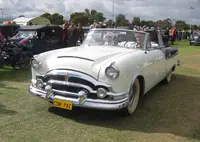Father's Day Special - HISTORY: PACKARD AT 100 +VIDEO
HISTORY: PACKARD AT 100
by Bob Hagin
Originally published April 16, 1999
Bob Hagin is Matt Hagin's father. Bob and Matt were regular contributors to TheAutoChannel.com in the 1990's
If he had lived past the age of 74, my dad would be 100 years old this year. His birth year was 1899, which is apropos to nothing except that the fabled Packard automobile was introduced that same year - and Dad was always a Packard fan as well as a Ford devotee.
Today's auto enthusiasts no doubt will find it hard to understand the veneration and adoration that the luxurious and precision-built Packard enjoyed. From its earliest days, the motto of its rival, the British Rolls-Royce, was the simple statement "The Best Car in the World." The motto of the American-built Packard was equally simple but asked only for verification from another source. Packard confidently (if politically incorrectly) requested that potential buyers "Ask The Man Who Owns One."
The Packard line was spawned from a dissatisfaction experienced by the brothers J.W and W.D. Packard, owners of a light industrial manufacturing company in Warren, Ohio, over the lack of quality and reliability they found in the Winton auto they bought in 1888. The brothers felt they could improve on it and the result was that a year later, they presented the first Packard, a tiller-steered, high-wheeled, single cylinder "horseless carriage". But it was far more advanced than most of its competition, and it soon sported a three-speed transmission that featured a reverse gear. Innovative engineering 100 years ago.
By the early days of the 20th Century, the name Packard was well on its way towards becoming the standard of American automotive quality and perfection. In 1903, drivers Tom Fetch and Marius Krarup (who was also the editor of the original Automobile magazine) drove an already-aging single-cylinder Packard Model F from San Francisco to New York in 61 days, an incredible record in the days of dirt roads and cow paths.
But small cars were not to be the future of the Packard Motor Car Company (a name adopted in 1902) and while its four-cylinder engines of the era rose in displacement to a monumental 432 cubic inches, it was the 1916 introduction of the world's first production-line V12 engine (known as the Twin Six) that established the Packard reputation of building big, luxurious automobiles.
It was probably one of these gigantic machines that created the affection that my dad had for Packards. He was a high-school student living in Berkeley and a well-to-do neighbor asked him to be a part-time chauffeur for the family. Apparently, the head of the household found it hard to develop driving skills and needed outside help. "I didn't know how to drive very well" Dad later recalled, "but I didn't tell him that and I was a quick learner". Obviously the streets of Oakland and Berkeley were relatively uncrowded during the First World War.
As an historical side note, in 1921, Warren G. Harding was the first American president to ride to his inauguration in an automobile and that machine was a Packard Twin Six touring car.
Like most other American industries during that war, Packard engaged in the production of war materiel and became the manufacturer of Liberty aviation engines and that experience heightened Packard's development of high-tech innovations. Several decades later, Packard returned to the production of powerplants for war use and its built-under-license V12s were found in PT boats as well as aircraft.
Throughout its life span, the Packard retained its reputation for quality even during the disastrous Depression of the '30s. To stay afloat, the company introduced its "Junior Packard" lines of small straight-eights (the 120 series) and even a much smaller 110 six- cylinder line, but the Packard quality was always a constant and the cars always carried the distinctive and traditional Packard grille.
When I was just out of high school, I worked for a woman who had one of these "little" Packards, a 110 coupe, and its fit-and-finish was equal to the custom-built Packard classics that I would come across at the myriad concours de elegance shows that were popular in the '50s.
But it was those huge carriage-trade "Senior Series" Packards of the '30s that I revere the most. I was even a partial owner of a V12 Town Car in the '50. Just sitting in it seemed to require conversation to be carried on in hushed tones.
Packard fell on hard times after World War II and although it bravely came on line with advanced V8 engines and modern styling, it couldn't compete with the Big Three, Ford, General Motors and Chrysler. Through a supposed life-saving merger with Studebaker, Packard hoped for resurrection but it was not to be and the last true Packard rolled off its Detroit assembly line in 1956. The name struggled on for two more years, attached to thinly-disguised Studebaker models and then the once-proud name vanished completely.
 1954 Packard Caribbean |
As fate would have it, the Packard name was gone, but not the car. Through a series of still-unexplained transfers of machine tools, body dies and technology, the pre-war "big" Packard was produced in the U.S.S.R. in the immediate post-war period under the ZIM and ZIL brand names. The just-pre-Studebaker Packard models were also copied in the late '70s and all were designated as ultra-luxury cars for important Communist party officials.
My dad would have had mixed emotions about that but as they say, imitation is the most sincere form of flattery.



